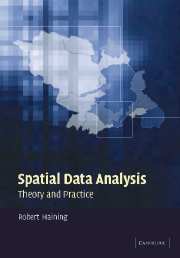Book contents
- Frontmatter
- Contents
- Preface
- Acknowledgements
- Introduction
- Part A The context for spatial data analysis
- Part B Spatial data: obtaining data and quality issues
- Part C The exploratory analysis of spatial data
- Part D Hypothesis testing and spatial autocorrelation
- Part E Modelling spatial data
- 9 Models for the statistical analysis of spatial data
- 10 Statistical modelling of spatial variation: descriptive modelling
- 11 Statistical modelling of spatial variation: explanatory modelling
- Appendix I Software
- Appendix II Cambridgeshire lung cancer data
- Appendix III Sheffield burglary data
- Appendix IV Children excluded from school: Sheffield
- References
- Index
10 - Statistical modelling of spatial variation: descriptive modelling
Published online by Cambridge University Press: 06 July 2010
- Frontmatter
- Contents
- Preface
- Acknowledgements
- Introduction
- Part A The context for spatial data analysis
- Part B Spatial data: obtaining data and quality issues
- Part C The exploratory analysis of spatial data
- Part D Hypothesis testing and spatial autocorrelation
- Part E Modelling spatial data
- 9 Models for the statistical analysis of spatial data
- 10 Statistical modelling of spatial variation: descriptive modelling
- 11 Statistical modelling of spatial variation: explanatory modelling
- Appendix I Software
- Appendix II Cambridgeshire lung cancer data
- Appendix III Sheffield burglary data
- Appendix IV Children excluded from school: Sheffield
- References
- Index
Summary
This is the first of two chapters dealing with some practical aspects together with examples of the statistical modelling of spatial data. This chapter considers models for describing spatial variation (‘descriptive’ modelling). The purpose of descriptive modelling is to find a representation of the variation of a response variable where covariates are not present in the model. The data, then, consist only of measurements on the variable of interest together with data on the location of each observation.
In 10.1 approaches to modelling spatial variation are discussed where parameters are assumed to be fixed values and estimated by likelihood methods. Section 10.1.1 reviews models for continuous-valued variables. Trend surface and covariance and semi-variogram modelling are covered. Section 10.1.2 examines models for discrete-valued variables. Section 10.2 reviews some special problems that arise in modelling spatial variation. Section 10.3 examines some Bayesian approaches to mapping spatial variation and provides an illustration using lung cancer data recorded at the ward level for Cambridgeshire.
Spatial variation may be captured directly through the correlation structure or through the specification of a spatial response function that refers to the mean of the process. Spatial variation may be modelled directly in terms of the observations or in terms of some unobserved parameter of interest that the observations depend on. The models of section 10.1include one or more ‘spatial’ parameters that describe and quantify the structure of spatial variation. The models of section 10.3 have no such spatial parameters and spatial variation is represented through spatial averaging.
- Type
- Chapter
- Information
- Spatial Data AnalysisTheory and Practice, pp. 325 - 349Publisher: Cambridge University PressPrint publication year: 2003



